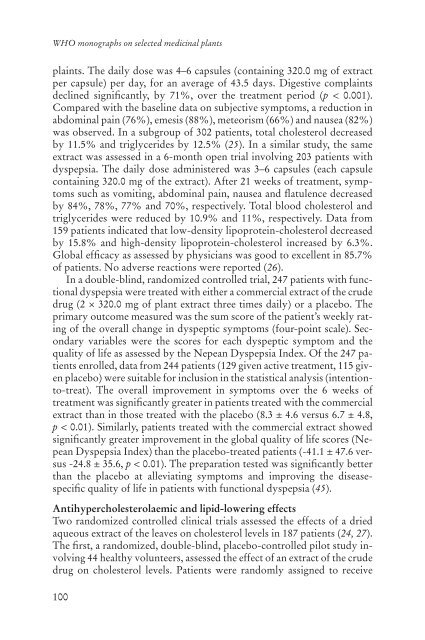WHO monographs on selected medicinal plants - travolekar.ru
WHO monographs on selected medicinal plants - travolekar.ru
WHO monographs on selected medicinal plants - travolekar.ru
Create successful ePaper yourself
Turn your PDF publications into a flip-book with our unique Google optimized e-Paper software.
<str<strong>on</strong>g>WHO</str<strong>on</strong>g> <str<strong>on</strong>g>m<strong>on</strong>ographs</str<strong>on</strong>g> <strong>on</strong> <strong>selected</strong> <strong>medicinal</strong> <strong>plants</strong><br />
plaints. The daily dose was 4–6 capsules (c<strong>on</strong>taining 320.0 mg of extract<br />
per capsule) per day, for an average of 43.5 days. Digestive complaints<br />
declined significantly, by 71%, over the treatment period (p < 0.001).<br />
Compared with the baseline data <strong>on</strong> subjective symptoms, a reducti<strong>on</strong> in<br />
abdominal pain (76%), emesis (88%), meteorism (66%) and nausea (82%)<br />
was observed. In a subgroup of 302 patients, total cholesterol decreased<br />
by 11.5% and triglycerides by 12.5% (25). In a similar study, the same<br />
extract was assessed in a 6-m<strong>on</strong>th open trial involving 203 patients with<br />
dyspepsia. The daily dose administered was 3–6 capsules (each capsule<br />
c<strong>on</strong>taining 320.0 mg of the extract). After 21 weeks of treatment, symptoms<br />
such as vomiting, abdominal pain, nausea and flatulence decreased<br />
by 84%, 78%, 77% and 70%, respectively. Total blood cholesterol and<br />
triglycerides were reduced by 10.9% and 11%, respectively. Data from<br />
159 patients indicated that low-density lipoprotein-cholesterol decreased<br />
by 15.8% and high-density lipoprotein-cholesterol increased by 6.3%.<br />
Global efficacy as assessed by physicians was good to excellent in 85.7%<br />
of patients. No adverse reacti<strong>on</strong>s were reported (26).<br />
In a double-blind, randomized c<strong>on</strong>trolled trial, 247 patients with functi<strong>on</strong>al<br />
dyspepsia were treated with either a commercial extract of the c<strong>ru</strong>de<br />
d<strong>ru</strong>g (2 × 320.0 mg of plant extract three times daily) or a placebo. The<br />
primary outcome measured was the sum score of the patient’s weekly rating<br />
of the overall change in dyspeptic symptoms (four-point scale). Sec<strong>on</strong>dary<br />
variables were the scores for each dyspeptic symptom and the<br />
quality of life as assessed by the Nepean Dyspepsia Index. Of the 247 patients<br />
enrolled, data from 244 patients (129 given active treatment, 115 given<br />
placebo) were suitable for inclusi<strong>on</strong> in the statistical analysis (intenti<strong>on</strong>to-treat).<br />
The overall improvement in symptoms over the 6 weeks of<br />
treatment was significantly greater in patients treated with the commercial<br />
extract than in those treated with the placebo (8.3 ± 4.6 versus 6.7 ± 4.8,<br />
p < 0.01). Similarly, patients treated with the commercial extract showed<br />
significantly greater improvement in the global quality of life scores (Nepean<br />
Dyspepsia Index) than the placebo-treated patients (-41.1 ± 47.6 versus<br />
-24.8 ± 35.6, p < 0.01). The preparati<strong>on</strong> tested was significantly better<br />
than the placebo at alleviating symptoms and improving the diseasespecific<br />
quality of life in patients with functi<strong>on</strong>al dyspepsia (45).<br />
Antihypercholesterolaemic and lipid-lowering effects<br />
Two randomized c<strong>on</strong>trolled clinical trials assessed the effects of a dried<br />
aqueous extract of the leaves <strong>on</strong> cholesterol levels in 187 patients (24, 27).<br />
The first, a randomized, double-blind, placebo-c<strong>on</strong>trolled pilot study involving<br />
44 healthy volunteers, assessed the effect of an extract of the c<strong>ru</strong>de<br />
d<strong>ru</strong>g <strong>on</strong> cholesterol levels. Patients were randomly assigned to receive<br />
100

















